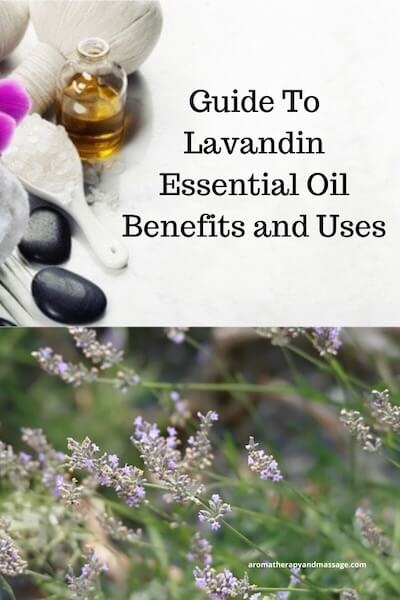- Home
- Essential Oil Profiles
- Lavandin Essential Oil
As an affiliate with Bookshop, Amazon, and other programs, I may earn revenue from qualifying purchases through affiliate links. This does not affect the price you pay. Privacy Policy / Disclosures. This site is for educational purposes only.
Search this site:
Guide to Lavandin Essential Oil Benefits and Uses
Lavandin essential oil (Lavandula x intermedia) is produced from a plant that's a hybrid of true lavender and spike lavender.
Lavandin is easier and cheaper to grow than true lavender and often used to adulterate lavender essential oil. Sometimes lavandin is mislabeled and sold as lavender, an important reason to find a trustworthy supplier of essential oils.

Plant family: Lamiaceae
Production: Steam distilled from the flowering tops of the plant. A lavandin absolute is also available.
Aroma: Fresh, sweet, floral—somewhat more herbaceous and camphorous than true lavender but less sharp than spike lavender.
Perfume/Aromatic note: Top to Middle.
System affinities: Skin, musculoskeletal, and emotions, according to The Ultimate Guide to Aromatherapy.
Is lavandin safe to use during pregnancy? Consult a professional.
Is lavandin essential oil safe for children? You might not want to use it with kids under age 2. Consult a professional.
Cautions: Do NOT use lavandin on burns—it can worsen irritation.
Main components: Essential Oil Safety, 2nd Edition, lists three types of this essential oil: Lavandin abrialis, Lavandin grosso, and Lavandin super. They have varying components, though the main ones in all three are linalool, linalyl acetate, camphor and 1,8-cineole.
Note: Lavandin contains more camphor than lavender and less than spike lavender. Camphor gives an oil a sharper scent and makes it more stimulating than relaxing.
Lavandin Aromatherapy Benefits
Aromatherapy: A Complete Guide to the Healing Art: You can use lavandin to help relieve muscle pain and as a disinfectant and deodorant.
The Healing Intelligence of Essential Oils: Lavandin is balancing and cleansing.
The Complete Book of Essential Oils and Aromatherapy: Lavandin may help relieve menstrual cramps, muscle cramps and spasms, muscle injuries, migraines, stress, tension and acne.
375 Essential Oils and Hydrosols and The Encyclopedia of Essential Oils (updated edition): Lavandin helps relieve conditions of the respiratory, muscular, and circulatory systems.
Therapeutic Blending With Essential Oils: Lavandin helps relieve muscle stiffness and joint soreness and clear sinus phlegm.
To help relieve muscle and joint pain, Aromatherapeutics Blending suggests blending lavandin with marjoram, nutmeg, or rosemary essential oil.
Aromatica: A Clinical Guide to Essential Oil Therapeutics, Volume I: Lavandin helps relieve mental-emotional conditions when diffused, used in a full-body massage oil, and applied to acupoints. Although lavandin uses are similar to true lavender, lavandin is more stimulating and can help address hypotonic (weak) conditions.
Mixing Essential Oils for Magic: Lavandin enhances awareness and intuition for dreamwork, clairvoyance, and all forms of psychic work and also supports concentration for clarity and inspiration for divination, contact with spirits, and communication in general. The oil is grounding and purifying.
Lavandin Essential Oil Uses and Blends
Common uses of lavandin oil include lotions, soaps, room sprays, cleaning products, and perfumes.
Eden's Garden: You can use lavandin in hair care. For washing your hair, to a bottle of unscented shampoo, add 12 drops of the essential oil for each ounce (2 tablespoons) of shampoo.
To make a hair oil treatment, blend:
- 6 drops lavandin essential oil
- 3 drops rosemary essential oil
- 3 drops peppermint essential oil
- 2 tablespoons argan oil
Massage the blend into your scalp. Wait at least 30 minutes. Wash your hair.
Deodorizing Spray
- 1 cup distilled water
- 1 cup witch hazel
- 30 drops lavandin essential oil
- 16-ounce (470 ml) spray bottle
- Solubilizer, if desired
To
the bottle, add water, witch hazel, essential oil, and solubilizer
according to package directions. Cap, then shake thoroughly.
To use: Shake. Spritz onto bed sheets, rugs, mats, and curtains to brighten and deodorize them. Adapted from New Directions Aromatics.
Foot Care Blend for Athletes
Blend the following essential oils in a small dark bottle:
- 9 drops lavandin
- 6 drops rosemary
- 6 drops manuka
- 4 drops thyme linalol
- 2 drops peppermint
To use the blend for foot massage, dilute 3 to 5 drops in 1 teaspoon carrier oil.
Source: The Complete Book of Essential Oils and Aromatherapy
Calming Diffuser Blend
- 2 drops lavandin essential oil
- 2 drops lavender essential oil
- 2 drops palmarosa essential oil
- 1 drop sweet orange essential oil
Everyday Face Cream
- 6 tablespoons moisture cream base for sensitive skin
- 1 teaspoon rosehip oil
- 3/4 teaspoon rose hydrosol
- 7 drops lavandin essential oil
- 7 drops palmarosa essential oil
- 4 drops sandalwood essential oil
- Put the moisture cream base into a 4-ounce glass jar and stir.
- Stir in the rosehip oil.
- Mix in the hydrosol.
- Drop in the essential oils. Stir well.
- Put on the lid, label, and store in a cool, dark place.
Use twice daily, morning and night.
Adapted from Penny Price
Photo Credit: David J. Stang, CC BY-SA 4.0, via Wikimedia Commons




